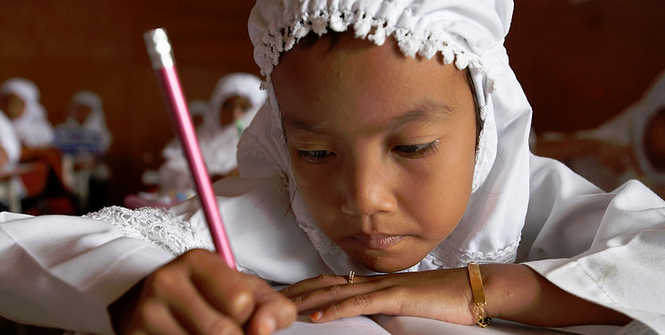Indonesia’s Education Challenge

Of all the many hurdles Indonesia faces in its efforts to develop, education is one core challenge which is vital to address.
The new President, Joko Widodo, has pledged to “lift-up the people” and has a vision to equip them with the skills and services to improve their lives. One of the most fundamental requirements to achieve this goal will be to improve education levels; a task that is both enormous and urgent.
Schoolchildren are lagging behind in a system that doesn’t serve them well, and reports have warned that even on the current trajectory those with an education are likely to be under-qualified to meet the needs of a growing economy. Meanwhile the tens of millions of factory workers reliant on low-skilled jobs are not being sufficiently trained for the next wave of manufacturing predicted for Indonesia.
The Minister in charge of early education, Anies Baswedan, has said that he realises there is much work ahead to capture the opportunity. There are some small signs of improvement. For example, as part of his promise to deliver growth and equality President Widodo has introduced a smart card that ensures financial support for the first 12 years of education for the nation’s poorest.
Mr Baswedan has spoken openly of his long-term vision and the challenge in implementing it. The country has more than 50 million schoolchildren who easily lose interest in the classroom and consequently lag behind their peers in other countries. “Looking at the quality of our education, you don’t have to be Superman to realise that something is wrong,” said Mr Baswedan told the audience at a conference held by The Economist group in Jakarta earlier this year.
Indonesia has a teacher ratio of around one for 16 students, but many areas don’t have enough teachers while others have too many. The Minister says that in some rural areas up to 60 percent of schools are under-staffed. He is concerned that children living more than two kilometres from a school face an uphill battle to continue their education. Teacher quality is another issue, with teachers scoring an average of 45/100 on a competency test, when it should be around 75.
In a private interview he set out a framework for the next five years, with the focus on several key areas which include, at the top of the list, empowering parents to be a part of their children’s education, supporting school principals and improving teacher standards.
He was asked at the Jakarta conference why the low-scoring teachers are still in their jobs. “That’s a good question”, he says. That’s a question we are asking.”
More of the Indonesian budget is now committed to education and while there have been gains it has not been evenly matched by an improvement in student capabilities. According to the survey known as PISA which measures OECD countries and others, 15 year-old students are well behind their peers in science, reading and maths.
Such a situation does not place them in an advantageous position to become the qualified professionals or skilled workers the country will need if it is to progress. A 2013 report by the Boston Consulting Group found that “by 2020 top companies will be unable to fill about one-half of their entry level position with fully-qualified candidates.”
At that same economics conference in Jakarta, the IMF Country Representative Ben Bingham said “education forms now are critical, so that in ten years time Indonesia has a labour force that can compete up the value-chain.” He also made the point that if the government does want to see a rapid increase in growth and social capital, it would require a significant rise in the amount of skilled labour.
The need to improve education levels, and also reduce inequality, is obvious in a country where more than half of the population rely on income from the informal sector.
There are also the tens of millions working in factories. Prominent unionists have been warning that these workers will be at a disadvantage when the trade barriers come down within the ASEAN economic community, as they cannot match the knowledge and training of their peers. And it is baseline training that is needed.
The Victorian Government’s office in Jakarta has identified vocational training needs for the private sector in certificates 1-4, improving low-level skills that would then help workers, and the country, to move into higher technology manufacturing. Training is done by local entities when possible, but more work is being done by VET entities offering courses and new players are entering the market.
There are other small programmes trying to close the gap and make a positive difference, such as one between Australia and Indonesia to train meat industry workers. Another initiative is looking at how to adopt and transfer some of the techniques used in Australian primary school classrooms into an Indonesian setting, which comes from Indonesian adults seeing their own children thrive in Australian classrooms.
The challenges are not unknown. How Indonesia deals with them is the larger question, and also whether it is willing to look outside for ideas and strategies on how to make the change.
Helen Brown, a senior journalist at the ABC, was based in Indonesia for 4 years as a correspondent from 2010-2014.





